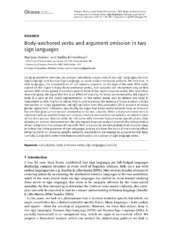| dc.description.abstract | Using quantitative methods, we analyze naturalistic corpus data in two sign languages, German Sign Language and Russian Sign Language, to study subject-omission patterns. We find that, in both languages, the interpretation of null subjects depends on the type of the verb. With verbs signed on the signer’s body (body-anchored verbs), null subjects are interpreted only as first person. With verbs signed in neutral space in front of the signer (neutral verbs), this restriction does not apply. We argue that this is an effect of iconicity: for body-anchored verbs, the signer’s body is a part of the iconic representation of the verbal event, and by default the body is interpreted as referring to the signer, that is, as first person. We develop a formal analysis using a mechanism of mixed agreement, taking inspiration from Matushansky’s (2013) account of mixed gender agreement in Russian. Specifically, we argue that body-anchored verbs bear an inherent feature that gives a first-person interpretation to null subjects. When a body-anchored verb is combined with an overt third-person subject, a feature mismatch occurs which is resolved in favor of the third person. Neutral verbs do not come with inherent feature-value specifications, thus allowing all person interpretations. We also explain how our analysis predicts the interpretation of null subjects in the context of role shift. With our account, we demonstrate that iconicity plays an active role in the grammar of sign languages, and we pin down the locus of the iconicity effect. While no iconic or modality-specific syntactic mechanisms are needed to account for the data, iconicity is argued to determine feature specification on a subset of sign language verbs. | en_US |

